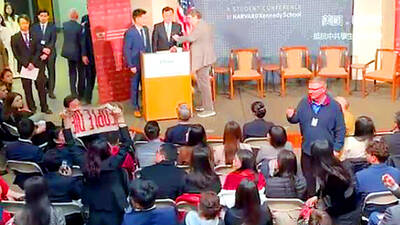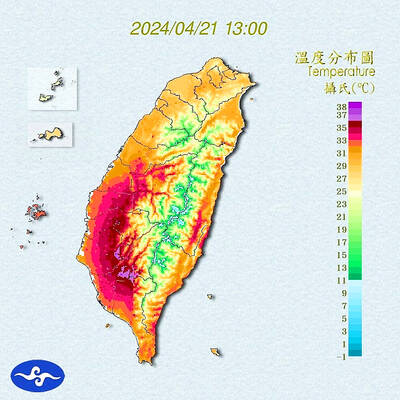Succulents are becoming more popular due to their resilience to drought and relatively little need for water amid an unusually dry year, an industry representative said.
Potted succulents have always been popular for their healing properties, but are now selling nearly 30 percent better than last year due to dry conditions, Huang Yi-pin (黃毅斌), chief of production and marketing at Cijia Fifth Street Floral Park in Tainan’s Gueiren District (歸仁), said on Monday.
A relatively dry season and a lack of typhoons have raised concerns over a drought until next year’s seasonal rains arrive in May, with the Water Resources Agency on Wednesday implementing phase-one water rationing measures in some areas.

Photo: Wu Chun-feng, Taipei Times
There are thousands of succulent varieties, with the most common belonging to the cactus family, Huang said.
Cacti come many fantastical shapes and can be used for many purposes, such as a modeling subject, to pair with other potted plants or for interior decoration, he said.
Other common succulents include aloe, the pencil tree, Lithops or pebble plants, and dogbanes that have flowers, but no thorns, Huang added.
Ghost plants with their striking rosettes and stonecrop perennials, such as Bryophyllum pinnatum, are also common houseplants, in addition to the popular “lover’s tears” scrambling succulent that belongs to the daisy family, he said.
The plants should be kept in a place with plenty of natural light and only need to be watered twice a month, although larger plants in pots that are at least 8cm in diameter can go four weeks without being watered, he added.
Aside from their medicinal uses as balms or ointments, succulents can also clean the air and absorb radiation, he said.
Huang also recommended that people try planting in a ball of moss or soil, instead of a pot, as it is more water-efficient, can be made easily and has an attractive decorative appearance.

A group of Taiwanese-American and Tibetan-American students at Harvard University on Saturday disrupted Chinese Ambassador to the US Xie Feng’s (謝鋒) speech at the school, accusing him of being responsible for numerous human rights violations. Four students — two Taiwanese Americans and two from Tibet — held up banners inside a conference hall where Xie was delivering a speech at the opening ceremony of the Harvard Kennedy School China Conference 2024. In a video clip provided by the Coalition of Students Resisting the CCP (Chinese Communist Party), Taiwanese-American Cosette Wu (吳亭樺) and Tibetan-American Tsering Yangchen are seen holding banners that together read:

UNAWARE: Many people sit for long hours every day and eat unhealthy foods, putting them at greater risk of developing one of the ‘three highs,’ an expert said More than 30 percent of adults aged 40 or older who underwent a government-funded health exam were unaware they had at least one of the “three highs” — high blood pressure, high blood lipids or high blood sugar, the Health Promotion Administration (HPA) said yesterday. Among adults aged 40 or older who said they did not have any of the “three highs” before taking the health exam, more than 30 percent were found to have at least one of them, Adult Preventive Health Examination Service data from 2022 showed. People with long-term medical conditions such as hypertension or diabetes usually do not

POLICE INVESTIGATING: A man said he quit his job as a nurse at Taipei Tzu Chi Hospital as he had been ‘disgusted’ by the behavior of his colleagues A man yesterday morning wrote online that he had witnessed nurses taking photographs and touching anesthetized patients inappropriately in Taipei Tzu Chi Hospital’s operating theaters. The man surnamed Huang (黃) wrote on the Professional Technology Temple bulletin board that during his six-month stint as a nurse at the hospital, he had seen nurses taking pictures of patients, including of their private parts, after they were anesthetized. Some nurses had also touched patients inappropriately and children were among those photographed, he said. Huang said this “disgusted” him “so much” that “he felt the need to reveal these unethical acts in the operating theater

Heat advisories were in effect for nine administrative regions yesterday afternoon as warm southwesterly winds pushed temperatures above 38°C in parts of southern Taiwan, the Central Weather Administration (CWA) said. As of 3:30pm yesterday, Tainan’s Yujing District (玉井) had recorded the day’s highest temperature of 39.7°C, though the measurement will not be included in Taiwan’s official heat records since Yujing is an automatic rather than manually operated weather station, the CWA said. Highs recorded in other areas were 38.7°C in Kaohsiung’s Neimen District (內門), 38.2°C in Chiayi City and 38.1°C in Pingtung’s Sandimen Township (三地門), CWA data showed. The spell of scorching